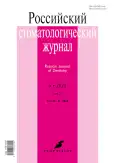Изучение соответствия трансверсальных размеров зубной дуги индексным параметрам (экспериментально-клиническое исследование)
- Авторы: Солдатова Л.Н.1,2, Шефова А.В.1,3, Прохорова В.В.1,4
-
Учреждения:
- Первый Санкт-Петербургский государственный медицинский университет имени академика И.П. Павлова
- Стоматологическая клиника «Альфа-Дент»
- Сеть стоматологических клиник «Видент»
- Стоматологическая клиника «Белая Медведица»
- Выпуск: Том 27, № 5 (2023)
- Страницы: 451-456
- Раздел: Клинические исследования
- URL: https://journals.rcsi.science/1728-2802/article/view/251374
- DOI: https://doi.org/10.17816/dent133695
- ID: 251374
Цитировать
Аннотация
Обоснование. Частота встречаемости зубочелюстных аномалий растёт ежегодно, что сопровождается увеличением обращаемости к врачам-ортодонтам с целью ортодонтического лечения. Качественная диагностика — залог успешного лечения и важный этап профилактики осложнений (рецессий, резорбции корней, анкилоза и т.п.).
Цель исследования — провести анализ соответствия трансверсальных размеров зубных рядов жителей Санкт-Петербурга и Ленинградской области референсным значениям индексов.
Материалы и методы. Было проведено вычисление суммы мезио-дистальных размеров четырёх верхних резцов и измерение ширины в области премоляров и моляров согласно методике, предложенной А. Поном. Далее выполнено сравнение параметров, полученных путём измерения в рамках исследования и рассчитанных с помощью индекса.
Результаты. Работа проведена с использованием контрольно-диагностических моделей 200 пациентов, подходящих под критерии включения в исследование. Все данные были статистически обработаны. Полученные результаты позволяют говорить о несоответствии индексных значений ширины для пациентов нашего региона. Так, расстояние между премолярами было меньше в среднем на 1,5 мм, чем рассчитанное по индексу, а между молярами — на 1,25 мм.
Заключение. Необходимы дальнейшие исследования для поиска новых ориентиров с целью повышения достоверности диагностических мероприятий.
Полный текст
Открыть статью на сайте журналаОб авторах
Людмила Николаевна Солдатова
Первый Санкт-Петербургский государственный медицинский университет имени академика И.П. Павлова; Стоматологическая клиника «Альфа-Дент»
Автор, ответственный за переписку.
Email: slnzub@gmail.com
ORCID iD: 0000-0002-4359-2179
SPIN-код: 2164-8583
доктор мед. наук, доцент
Россия, 197022, Санкт-Петербург, ул. Льва Толстого, д. 6-8; Санкт-ПетербургАнастасия Владимировна Шефова
Первый Санкт-Петербургский государственный медицинский университет имени академика И.П. Павлова; Сеть стоматологических клиник «Видент»
Email: lav61299@gmail.com
ORCID iD: 0000-0001-6912-8027
SPIN-код: 9676-3854
клинический ординатор стоматологии детского возраста и ортодонтии, врач-стоматолог
Россия, 197022, Санкт-Петербург, ул. Льва Толстого, д. 6-8; Санкт-ПетербургВиктория Валерьевна Прохорова
Первый Санкт-Петербургский государственный медицинский университет имени академика И.П. Павлова; Стоматологическая клиника «Белая Медведица»
Email: prohorovaviktorii@gmail.com
ORCID iD: 0000-0002-8075-8836
ассистент кафедры стоматологии детского возраста и ортодонтии, врач-ортодонт
Россия, 197022, Санкт-Петербург, ул. Льва Толстого, д. 6-8; Санкт-ПетербургСписок литературы
- Попова Н.В., Арсенина О.И., Гаврилова М.В., Попова А.В., Глухова Н.В. Применение дуг Питтса широкой формы и ранней эластичной тяги при лечении пациентов с сужением и деформацией зубоальвеолярных дуг // Ортодонтия. 2021. № 1. С. 58–62.
- Доменюк Д.А., Давыдов Б.Н., Ведешина Э.Г., Дмитриенко С.В., Гаглоева Н.Ф. Морфометрическая оценка зубочелюстных дуг при физиологической окклюзии постоянных зубов // Институт стоматологии. 2015. № 4. С. 74–77.
- Закалата Т.Р. Анализ результатов лечения трансверзальных аномалий у пациентов различных возрастных групп // Современная ортодонтия. 2015. № 4. С. 40–42.
- Housley J.A., Nanda R.S., Currier G.F., McCune D.E. Stability of transverse expansion in the mandibular arch // Am J Orthod Dentofacial Orthop. 2003. Vol. 124, N 3. P. 288–293. doi: 10.1016/s0889-5406(03)00450-5
- Celebi A.A., Tan E., Gelgor I.E. Determination and application of Pont’s index in Turkish population // The Scientific World Journal. 2012. Vol. 2012. 494623. doi: 10.1100/2012/494623
- Агашина М.А., Фищев С.Б., Лепилин А.В., Дмитриенко С.В., Балахничев Д.Н. Параметры зубных дуг верхней и нижней челюстей в трансверсальном направлении // Стоматология детского возраста и профилактика. 2017. Т. 16, № 1. С. 36–39.
- Шумилина В.А., Бородина В.А. Сравнительная оценка применения методов биометрического анализа гипсовых моделей челюстей // Современные методы диагностики, лечения, и профилактики стоматологических заболеваний. Ставрополь, 2018. С. 168–170.
- Stifter J. A study of Pont’s, Howe’s, Ree’s, Neff’s and Bolton analyses on Class I adult dentitions // Angle Orthod. 1958. Vol. 28. P. 215–225.
- Полякова В.В., Данилова М.А. Выбор эталонов для прогнозирования антропометрических параметров верхнего зубного ряда // Стоматология детского возраста и профилактика. 2016. Т. 15, № 4. С. 57–60.
- Gupta D.S., Sharma V.P., Aggarwal S.P. Pont’s Index as applied on Indians // Angle Orthod. 1979. Vol. 49, N 4. P. 269–271.
- Rathi M.K., Fida M. Applicability of Pont’s index in orthodontics // J Coll Physicians Surg Pak. 2014. Vol. 24, N 4. P. 256–260.
- Sajib N.H., Alam M.K. Validity of Pont’s analysis in a sample of Bangladeshi orthodontics patients // J Oral Res. 2017. Vol. 6, N 2. P. 36–38. doi: 10.17126/joralres.2017.015
- Al-Omari I.K., Duaibis R.B., Al-Bitar Z.B. Application of Pont’s Index to a Jordanian population // Eur J Orthod. 2007. Vol. 29, N 6. P. 627–631. doi: 10.1093/ejo/cjm067
Дополнительные файлы








